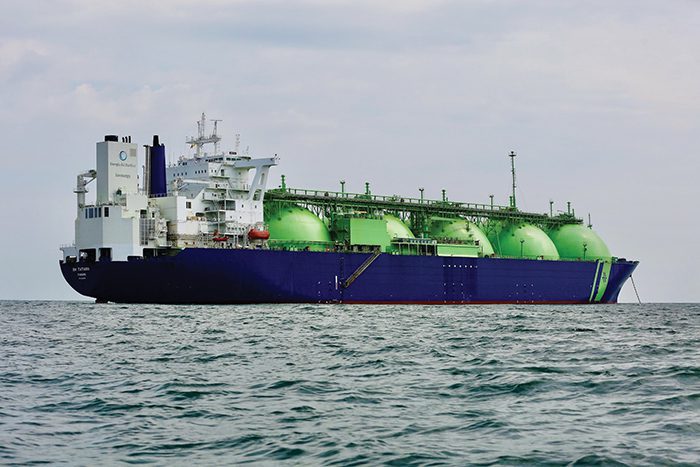A years-long energy project in El Salvador recently reached a milestone, as technology company Wärtsilä in November announced the installation and successful operation of a floating storage and regasification unit (FSRU, Figure 1) that will provide fuel for the 378-MW Energía del Pacifíco (EdP) power station. The facility, located at the Port of Acajutla, is a three-part project, including the thermal power plant, liquefied natural gas (LNG) regasification terminal, and transmission line.
 |
|
1. This floating storage and regasification unit, operated by Invenergy, provides fuel for the 378-MW Energía del Pacifíco power station in El Salvador. Courtesy: Wärtsilä |
The project was developed and is operated by Invenergy. The combined cycle power plant features 19 Wärtsilä 18V50SG natural gas–powered reciprocating engines, each rated at 18.9 MW, and one 28-MW Wärtsilä steam turbine generator powered by steam produced from the heat recovered in each engine’s exhaust. The power project, which began taking shape in 2013, is important for El Salvador because it offers cleaner energy production, replacing heavy fuel oil for power generation while offering flexibility the country needs to support the addition of more renewable energy resources to the national power grid.
The project has gone through many steps over the past several years in order to enter operation in 2022. Raúl Carral, business development manager for Latin America North with Wärtsilä Energy, and the company’s Path to 100% Community Expert, told POWER, “The Energía del Pacífico is a major undertaking with several major steps that required a substantial amount of work to materialize. In January 2013, there was an RFP [request for proposals] issued by the distribution companies in El Salvador for 350 MW [of] firm capacity with proposals to be submitted by October of that year.” Carral said, “During a nine-month period in 2013, there was a great deal of effort invested in getting the winning technological solution with a 378-MW power plant based on a combined cycle with reciprocating engines with the W50DF engine and the LNG supply. This combination resulted in the winning proposal of the bid. However, the gas supply still needed to be contracted.”
Carral said a tender was launched in 2015 for a 12-year supply of LNG, and in October 2016, the construction contract between Wärtsilä and EdP was finalized. “Subsequently, in 2017, EdP announced the signing of a contract for the purchase and sale of natural gas with Shell International Trading Middle East,” Carral said. “The next big step in this project was to get a new majority investor on board.” Invenergy in 2019 became the major shareholder of the project.
Electricity Imports
El Salvador currently imports about one-quarter of the country’s total electricity, making it the largest importer of electricity in Central America. Government officials have said the heavy reliance on imported power creates energy security risks, along with providing an economic challenge. Officials said the EdP project, expected to supply about 30% of the country’s total electricity, will reduce imports of power to about 5% in 2023.
Carral said additional contracts related to the project were pursued for different technology solutions. The FSRU includes partnerships with BW LNG and BW Offshore. Saam Towage was contracted to tow the FSRU to the location; that company serves customers from Canada, Mexico, Central America, and South America.
“The LNG delivered to the FSRU will be regasified and transported from the FSRU to the power plant through an underwater gas pipeline designed and built by the maritime infrastructure contractor Boskalis,” Carral said, with the regasification and power generation systems onboard the FSRU provided by Wärtsilä Gas Solutions. “Elecnor was contracted to install the high-voltage line, which will be approximately 44 kilometers, to connect to the Central American Electrical Interconnection System, which will strengthen the country’s electricity grid.”
Funding came from several multilateral financial organizations, including the International Finance Corp. (IFC), Overseas Private Investment Corp. (OPIC), Finnish Export Credit Ltd., UK-based KfW IPEX-Bank, and IDB Invest. Carral said financing was completed in December 2019, and represents a foreign direct investment of about $1 billion for El Salvador—the largest private investment ever made in the country.
Sampo Suvisaari, Wärtsilä Energy’s business director for Latin America North, said, “Another unique feature of this flexible power plant will be the ability to produce energy efficiently even at partial loads. This type of project is an exciting development for us as innovators and as partners in the energy transition in El Salvador.”
Construction Jobs
The EdP project has employed more than 1,400 workers during construction, with about 80 permanent jobs available for the completed project. The permanent jobs will involve operation and maintenance of the power plant, the FSRU, and the accompanying infrastructure. Invenergy said the EdP project represents the first permanently moored FSRU on the Pacific coast of the Americas.
Carral told POWER the Wärtsilä Dry Flexicycle power plant concept selected for the EdP project “offers high-efficiency reciprocating engines” that are combined with a steam cycle, with close to zero water consumption. The plants can be optimized for power within a range of 60 MW to 600 MW. Depending on the need, the number of prime movers (combustion engines) can vary and any initial investment can easily be expanded in 10-MW to 20-MW blocks, when needed. Each engine is equipped with a heat recovery steam generator and the plant utilizes a common steam turbine with a radiator-based cooling system. The solution is said to offer fast start-up and excellent load following capabilities, which are beneficial during peak hours such as hot summer days. This technology can also integrate renewable energy, which is significantly growing in Central America.
Carral said the project “will allow El Salvador to become less reliant on importing energy through the SIEPAC [Sistema de Interconexión Eléctrica de los Países de América Central] transmission line, which offers electricity to Central America’s power grid.” The SIEPAC line is the electrical transmission grid that runs from Guatemala to Panama, connecting the six Central American countries.
“Historically, electricity generation in the region has been highly dependent on hydroelectric plants as well as plants powered by diesel and fuel oil,” said Carral. “This matrix has negatively impacted energy costs and security of supply, which has caused frequent blackouts for most of the country. The SIEPAC transmission system has also presented congestion problems, which has created reliability issues for countries that heavily rely on importing electricity via this system. The new project will be fueled by natural gas and will bring the overall cost of electricity down while providing firm, reliable power to the country.”
The project also represents a major commitment for the IFC, which is helping EdP establish a long-term Corporate Social Responsibility Plan, a first of its kind in El Salvador. The plan is based on IFC’s Social and Environmental Sustainability standards. IFC will provide technical support and guidance to support EdP’s capacity to manage environmental and social risks, particularly pertaining to emissions, along with other impacts to both land and marine biodiversity.
—Darrell Proctor is a senior associate editor for POWER (@POWERmagazine).










